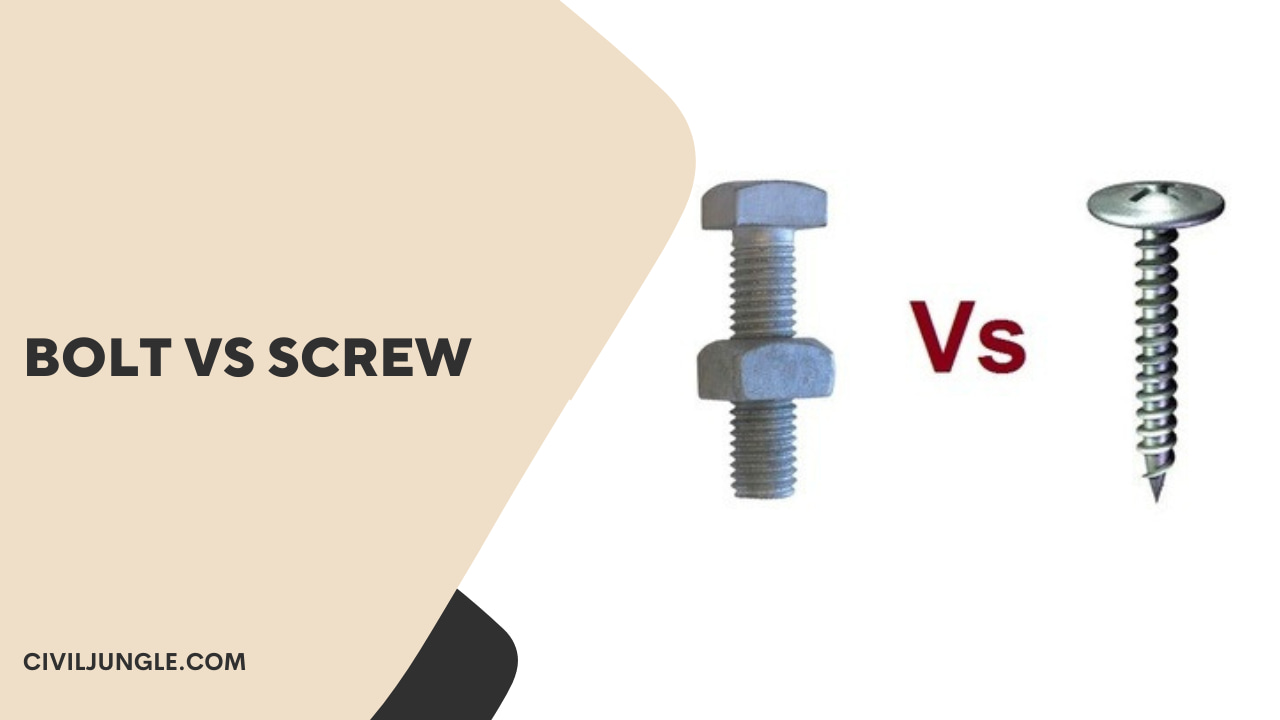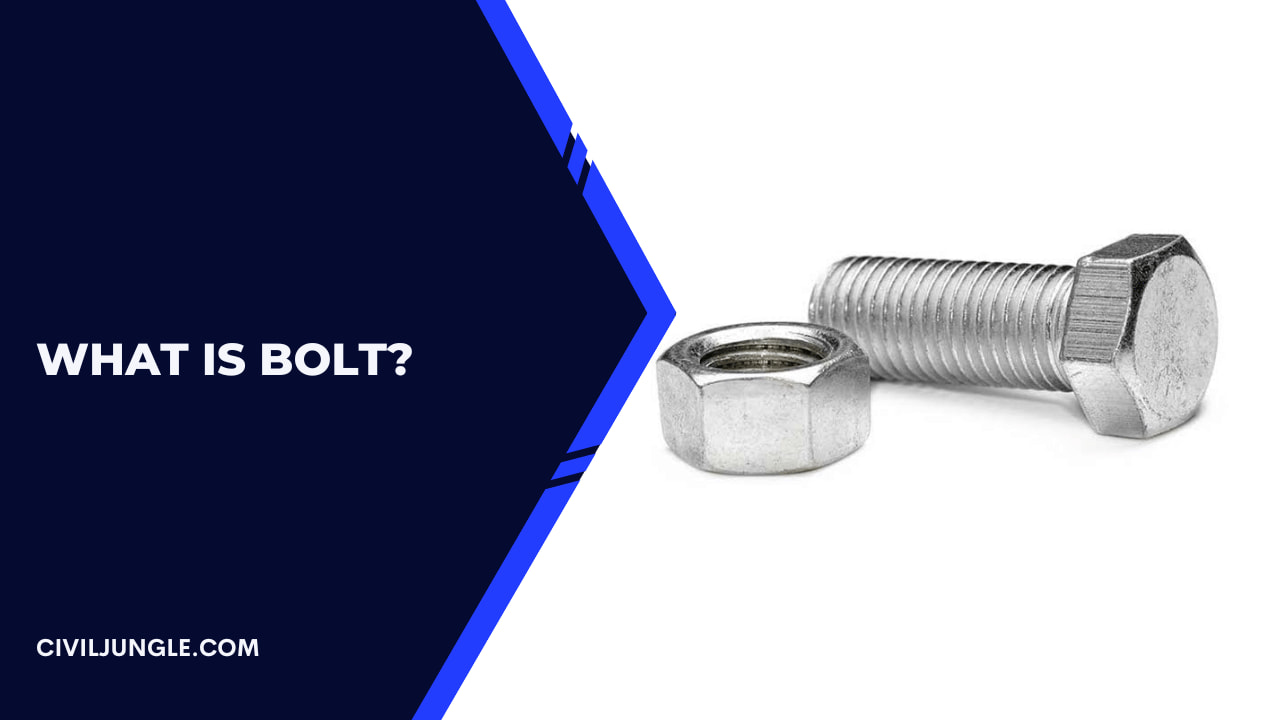What Is Bolt?
Important Point
A bolt is an externally threaded fastener created for the insertion through holes in the assembled parts. Generally, bolts are intended to be released by nuts.
This Bolts in a uniform circular cross-section, the threads are spiral in structure and have a smaller pitch as compared to screws. These bolts don’t have tapered shanks, and the parts secured by bolts possess greater strength than parts secured by screws.
These bolts act on the application together with the nut and are tightened on the part in which the torque is applied. Some of the generally used bolts are plow bolts, carriage bolts, and track bolts. The reliability and durability of parts joined by bolts are much higher than those joined by screws.
Applications that use bolts include flange joints or fastening of objects made of metal materials. Moreover, bolts aren’t only used in machinery but also plumbing and electronics. Z Bolts are an integral part of equipment and component reliability.
Also Read: Screw Washer Types
Bolt Pretension
Bolt Preload – The tension created when the nut is screwed onto a bolt to hold two materials together.
When the tension reaches the optimal preload, the working load (load added after creating the assembly) placed on a bolt will be distributed into the installation materials, so the bolt does not take the entire load.
Also, read: What Is Spalling Concrete?
What Is Screws?
A screw may be defined as an inclined plane wrapped around a nail and characterized by a helical ridge. In other words, it is a long metal shaft with threads circling along its length. It also has a turning where a screwdriver can be used to rotate the screw.
A screw generally has a head with a specially formed shape. The shape determines and heads size the size of the tool to be used to turn or drive the screw. Commonly used tools are wrenches and screwdrivers.
The underside part of the head is a shank that can be fully or partially threaded. A screw thread is a structure on a coned or cylindrical shape in the form of a helix.
The top of the ridge is known as a crest and the bottom root. The distance between the crest of the one thread to the next one is known as a pitch.
Screws are tightened by rotating the tool anticlockwise or clockwise and are usually used for joining materials that don’t have existing holes in them.
The most common types of screws used in manufacturing are drywall screws, dowel screws, mirror screws, and concrete screws. The strength of a screw relies on the width of the thread and the distance between them.
However, the more numbers of the threads, the more rotations would be required to attach the screw. Also, if the continuous distance thread is wider, more force must be exerted on the tool in the rotations.
Screws are widely used in many applications. From motorcycles to furniture, from air conditioners to kid’s remote control cars.
Also, read: Why Is Polymer Mortar/Concrete?
Bolt Vs Screw
Difference between nolt and screw are as follows.
| Sr.No. | Bolt | Screw |
| 1 | Screws are tightened by rotating the tool clockwise and are usually used for joining materials that do not have existing holes in them. | A screw is an externally threaded fastener capable of being inserted into holes in assembled parts, of mating with a preformed internal thread or forming its own thread, and of being tightened or released by torquing the head. |
| 2 | Bolt is always used in pair like nut & Bolt | Screws are always used by itself. |
| 3 | Bolts are used with un-threaded components. | Screw can be used with threaded or un-threaded components. |
| 4 | In the bolt cross Uniform section | In screw can have non- uniform cross section |
| 5 | The threads are spiral in shape. | The threads are helical in shape. |
| 6 | It doesn’t have tapered shank. | It has tapered or pointed shank. |
| 7 | This Bolts mostly require wrenches and spanners for the tightening and loosening purposes. | This screw requires mostly screw drivers for the tightening and loosening purposes. |
| 8 | This bolt is reliable | Here, Screw is less reliable |
| 9 | Bolts are larger in size. | Screws are smaller than bolts. |
| 10 | Larger size bolts are used to achieve higher load-carrying capacity. | Screws are not available in very large size. They are generally used for low load carrying applications. |
| 11 | Bolt are always fixed at a single position with the use of a tool. | Screws has to be turned every time it has to be assembled. |
| 12 | They apply compression on the parts that they join. | They don’t apply compression on the parts that they join. |
| 13 | They are often used in the making of bolted joints. | They can’t be involved in the bolted joint making due to the presence of at least one thread. |
| 14 | The examples of bolts are Anchor bolt, T-head bolt, Toggle bolt, U-bolt, J-bolt, Eyebolts, Hexagon bolt/Tap bolt, Lag bolt, Machine bolt, Carriage bolt, Elevator bolt, Flange bolt, Hanger bolt, Plow bolt, Shoulder bolt, Square head bolt, Stud bolt, Timber bolt, etc. | The examples of screws are self-drilling, socket screw, eye lag, mating screw, Wood screw, machine screw, thread cutting machine screw, sheet metal screw, set screw, etc |
Bolt vs Screw
So, the fundamental difference between screws and bolts is that the former is used to assemble threaded objects, while the latter is used to assemble untreaded objects. It’s also worth noting that screws must be turned to assemble a joint, while bolts can be secured in place using a tool or a carriage bolt.
Difference Between Screw and Bolt
A bolt is a non-tapered fastener that uses a washer and nut to hold objects together. A screw is a tapered fastener that mates with an existing thread or creates its own thread in a material as it turns.
Bolt Vs Screw Strength Comparison
Remember: bolts provide a tremendous amount of holding strength whereas screws offer a middle-ground for holding power. Light to medium construction projects, like for fencing or framing, are best for screws. Your heavy-duty projects are best for bolts.
Pros and Cons of Using Bolts Vs Screws
Uses Screws and bolts are both used to fasten objects together, but bolts are for more heavy-duty projects. While bolts are the better choice for construction, building, or anchoring items, screws are best for home repairs, hanging objects, and DIY builds.
Bolt and Screw Applications in Construction
Construction bolts have a wide range of uses, including securing beams to columns or walls; attaching joists to ledgers; setting up decks; fastening deck boards; attaching siding; installing light fixtures; mounting cable trays; fastening wood members together; forming secure foundations for bridges or buildings; and …
Bolt Versus Screw Comparison
They are both threaded fixings and have a head for tightening the fastener but there is more to it than that. The most obvious way of differentiating between a bolt and a screw is that a bolt is not usually threaded all the way along its shank as it has a plain portion. A screw, however, is threaded fully to the head.
Choosing the Right Bolt or Screw
This is how you choose the right bolt for the joint:
- First, identify the load case.
- Determine the necessary clamping force in the joint.
- Choose the smallest bolt diameter that can support the clamp load.
- Choose an effective bolt securing method.
- Decide on the most appropriate tightening method.
Bolt Vs Screw Vs Nut
A nut is a component that fits over the end of a bolt and helps it hold objects in place. A bolt is a non-tapered fastener that uses a washer and nut to hold objects together. A screw is a tapered fastener that mates with an existing thread or creates its own thread in a material as it turns.
Difference Between Nut and Bolt
Bolts have a head on one end that is used to grip the material, while nuts have a head on one end that is used to grip the bolt. Bolts are inserted into holes and tightened using a wrench, while nuts are threaded onto bolts and tightened using a wrench.
What Does a Bolt Look Like?
A bolt usually has a flat tip and is built to work with a matching nut, and is engineered to be torqued by the nut. A machine screw is actually closer to a bolt than a screw. A machine screw threads into a nut or an insert, but unlike a bolt, it is meant to be tighted by the head of the machine screw.
What Is the Difference Between Bolts and Screws?
So, the fundamental difference between screws and bolts is that the former is used to assemble threaded objects, while the latter is used to assemble untreaded objects. With that said, screws can make their own threads during the installation process.
How Many Types of Bolt?
Some bolt types include hex head bolts, square head bolts, u bolts, and eye bolts. Some nut types include coupling nuts, flange nuts, square nuts, and cap nuts. This guide will tell you about more than 30 different types of bolts and nuts and washers, as well as some of their applications.
Cap Screw Vs Bolt
Cap screws typically have a smaller diameter than bolts and usually have a shorter length. Bolts typically have a larger diameter than cap screws and are usually longer. Cap screws typically require a nut for installation, while bolts usually do not.
Machine Screw Vs Bolt
Machine screws may look like bolts, but they aren’t necessarily the same. Machine screws have a slotted head, whereas bolts have a hex head. With a slotted head, machine screws can be installed using a screwdriver, such as a Philips head or flat-heat screwdriver.
Carriage Bolt Vs Hex Bolt
Carriage bolts differ from regular hex bolts as they have a domed head that does not required a wrench for installation. The square shape underneath the head helps prevent the bolt from turning once set into position, either embedded in wood or into a square metal hole.
Like this post? Share it with your friends!
Suggested Read-
- Initial Setting Time of Ppc Cement
- Difference Between Lap Length and Development Length
- Tension Vs Compression | What Is Tension & Compression
- Difference Between Plasticizer And Superplasticizer in Civil
- Difference Between Plinth Level, Sill Level, and Lintel Level
- Difference Between One Way Slab and Two Way Slab | What is Slab
- Difference Between Timber And Wood | What is Wood | What is Timber
- Difference Between Beam and Column | What Is Beam | What Is Column
- Difference Between Bridge and Culvert | What Is Bridge | What Is Culvert
- Difference Between Flyover and Bridge | What Is Flyover | What Is Bridge
- Difference Between M Sand Vs River Sand | What is M-Sand & River Sand
- Difference Between Footing and Foundation | What is Footing and Foundation
- Difference Between Short Column and Long Column | What Is Column | Type of Column
- Difference Between Mortar and Concrete | What Is Mortar & Concrete | Type of Mortar &Concrete
- Difference Between Flexible Pavement and Rigid Pavement | What is Pavement | Type of Pavement
- Difference Between Pre-Tensioning and Post-Tensioning | What Is Prestressed | Methods of Prestress
Originally posted 2023-08-02 13:09:33.





Leave a Reply